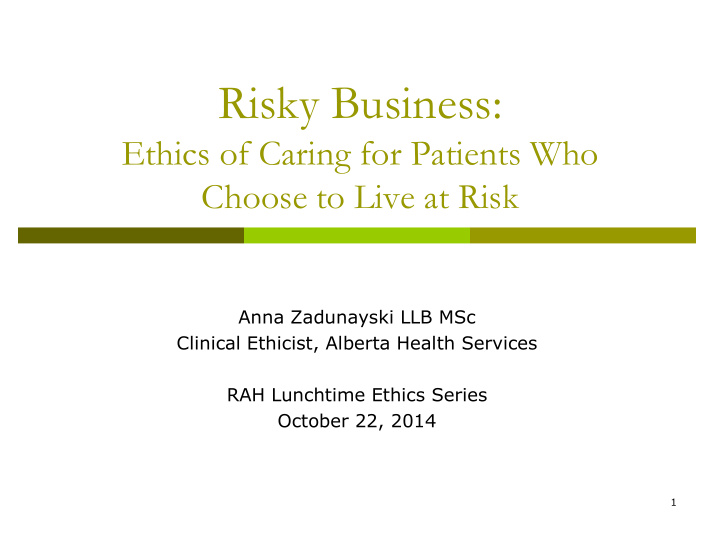



Risky Business: Ethics of Caring for Patients Who Choose to Live at Risk Anna Zadunayski LLB MSc Clinical Ethicist, Alberta Health Services RAH Lunchtime Ethics Series October 22, 2014 1
Objectives Discuss recent clinical ethics cases involving patients choosing to live at risk Identify principles for ethical decision making applicable to patients who choose to live at risk Review the ways in which clinical ethics can support complex health care decision making October 22, 2014 2
Ethics Service Support for families and teams facing difficult decisions Clinician model, Committee Model Ethics consultation Formal Informal Retrospective Facilitation of meetings and discussions Staff debriefing sessions 3 3
4
Relevance Threshold for moral culpability Living at risk Living arrangements / social arrangements Patients who smoke Patients with addictions Patients who traffic Patients who manipulate the health care system Financial pressures Complex family dynamics Physicians, nurses, social workers, administration, security Care planning Compassion fatigue Role of ethics consultation October 22, 2014 5 5
Principles of Ethics Autonomy Respect for patient autonomy; informed consent a common thread Beneficence Obligation to „do good‟; act in a way that is likely to benefit the patient; proceeding with a beneficent plan of care, using clinical judgment Nonmaleficence Ethical obligation not to harm or cause injury; to prevent foreseeable harm Justice Issues involving allocation of resources; organizational ethics; availability of services; “like cases”; fairness; equity 6 6
Case: 74 year old woman A 74 year old woman living alone with some family supports and some home care support Brittle diabetic with multiple comorbidities Blindness Hard of hearing Right below knee amputation Husband passed away one year ago Falls in bathroom and hits head; intra-ocular hemorrhage Presents in ED; pain, confusion, concerning hx Reluctanly admitted to medical unit Hospital stay exceeds 8 weeks; patient wishes to return home Health care team concerned about discharge October 22, 2014 7 7
What is the right thing to do? Role of Clinical Ethics? Principled decision making Autonomy Beneficence Nonmaleficence Distributive justice Who comprises the health care team? Consultation / documentation / recommendations October 22, 2014 8 8
Outcome 9 9
Case: 21 year old man A 21 year old male admitted to medical unit Renal failure Diet Polysubstance abuse Strained family relationships Using drugs while in hospital Selling drugs outside of hospital Leaving hospital without notifying staff Patient wishes to leave hospital Health care team / hospital administration request an ethics consultation October 22, 2014 10 10
What is the right thing to do? Role of Clinical Ethics? Principled decision making Autonomy Beneficence Nonmaleficence Distributive justice Who comprises the health care team? Consultation / documentation / recommendations 11 11
Outcome 12 12
Fatigue & Distress Compassion Fatigue is different from Moral Distress: Compassion Fatigue A gradual lessening of compassion over time Exemplified by frustration, cynicism, plateauing of moral development, decrease in productivity, burnout Overcome by self-care, balance, reflection, improved self-awareness, modification of attitudes Moral Distress Suffering or residue caused by disequilibrium between identifying ethical action and undertaking ethical action Internal (belief system, values) or external (systemic, organizational) barriers to pursuing the right course of action Occurs in the face of the true ethical dilemma Impacts inter-personal and inter-professional communication Alleviated through good communication and debriefing 13
Conclusions & Recommendations Allow for reflection Identify stakeholders Consultation Documentation / charting Communication with primary care providers / supports Clinical creativity / exploring options Debrief 14 14 Repeat
What clinical ethics resources are available to you? General Inquiries For all AHS Staff, Physicians, Patients & Families: 1-855-943-2821 clinicalethics@albertahealthservices.ca 15 15
Questions? October 22, 2014 16 16
References Alfandre, D. Reconsidering against medical advice discharges: embracing patient-centeredness to promote high quality care. J Gen Intern Med 2013 Dec; 28(12): 1657-62. Dhalla, I.A., Laupacis, A. et al. Effect of a postdischarge virtual ward on readmission or death for high risk patients: a randomized clinical trial. JAMA 2014 Oct 1; 312(13): 1305-12. Edwards, S.B., Wulf, K. et al. Safety issues at the end of life in the home setting. Home Healthc Nurse. 2014 Jul; 32(7): 396-401. Jones, C.D., DeWalt, D.A. et al. A failure to communicate: A qualitative exploration of care coordination between hospitalists and primary care providers around patient hospitalizations. J Gen Intern Med. 2014 Oct 15. Van Nistelrooy,I. Self-sacrifice and self-affirmation within care-giving. Med Health Care Philos. 2014 Nov; 17(4): 519-28. October 22, 2014 17
Recommend
More recommend